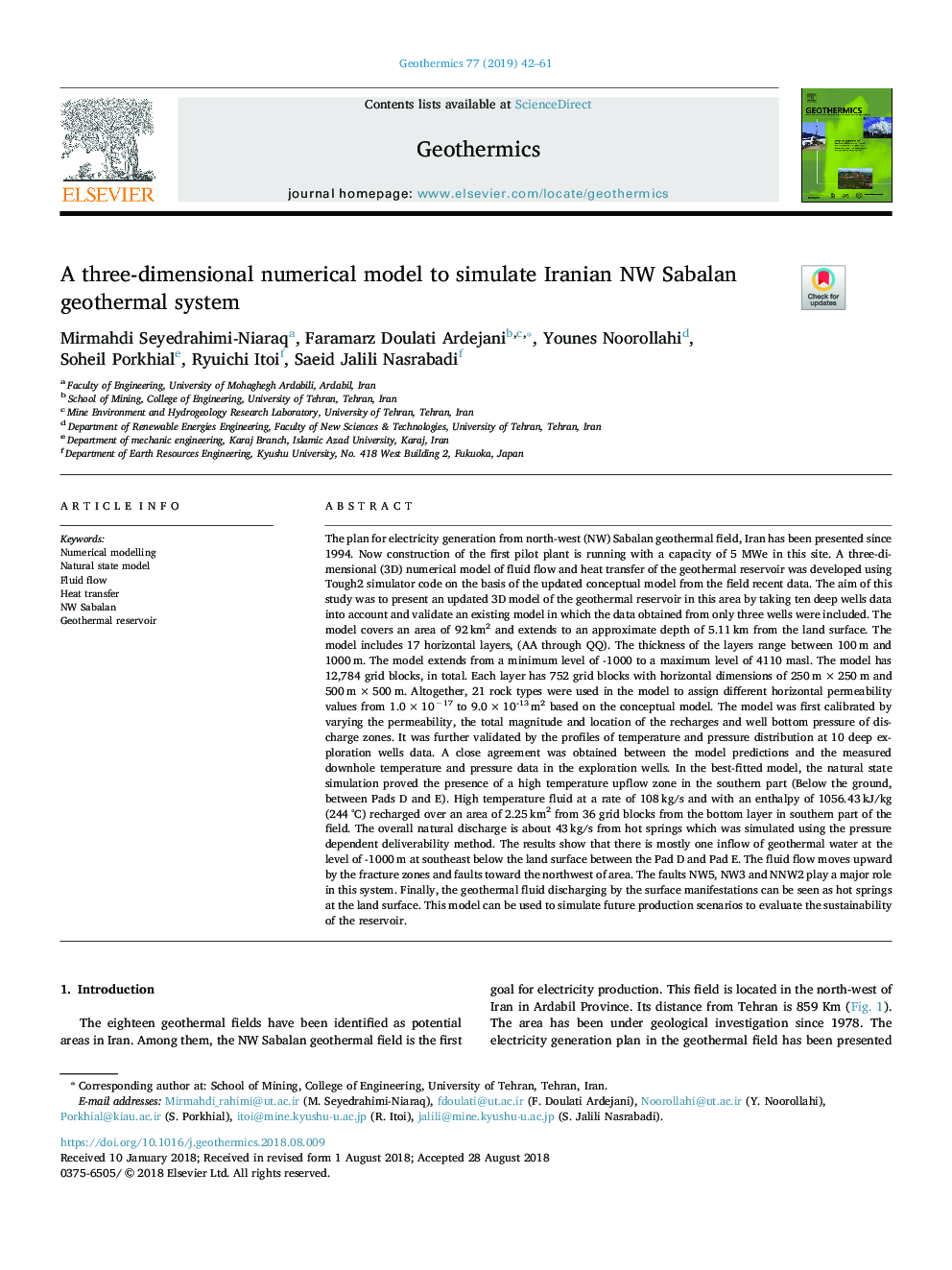| کد مقاله | کد نشریه | سال انتشار | مقاله انگلیسی | نسخه تمام متن |
|---|---|---|---|---|
| 10136322 | 1645683 | 2019 | 20 صفحه PDF | دانلود رایگان |
عنوان انگلیسی مقاله ISI
A three-dimensional numerical model to simulate Iranian NW Sabalan geothermal system
دانلود مقاله + سفارش ترجمه
دانلود مقاله ISI انگلیسی
رایگان برای ایرانیان
کلمات کلیدی
موضوعات مرتبط
مهندسی و علوم پایه
علوم زمین و سیارات
ژئوشیمی و پترولوژی
پیش نمایش صفحه اول مقاله

چکیده انگلیسی
The plan for electricity generation from north-west (NW) Sabalan geothermal field, Iran has been presented since 1994. Now construction of the first pilot plant is running with a capacity of 5 MWe in this site. A three-dimensional (3D) numerical model of fluid flow and heat transfer of the geothermal reservoir was developed using Tough2 simulator code on the basis of the updated conceptual model from the field recent data. The aim of this study was to present an updated 3D model of the geothermal reservoir in this area by taking ten deep wells data into account and validate an existing model in which the data obtained from only three wells were included. The model covers an area of 92âkm2 and extends to an approximate depth of 5.11âkm from the land surface. The model includes 17 horizontal layers, (AA through QQ). The thickness of the layers range between 100âm and 1000âm. The model extends from a minimum level of -1000 to a maximum level of 4110 masl. The model has 12,784 grid blocks, in total. Each layer has 752 grid blocks with horizontal dimensions of 250âmâÃâ250âm and 500âmâÃâ500âm. Altogether, 21 rock types were used in the model to assign different horizontal permeability values from 1.0âÃâ10â17 to 9.0âÃâ10-13âm2 based on the conceptual model. The model was first calibrated by varying the permeability, the total magnitude and location of the recharges and well bottom pressure of discharge zones. It was further validated by the profiles of temperature and pressure distribution at 10 deep exploration wells data. A close agreement was obtained between the model predictions and the measured downhole temperature and pressure data in the exploration wells. In the best-fitted model, the natural state simulation proved the presence of a high temperature upflow zone in the southern part (Below the ground, between Pads D and E). High temperature fluid at a rate of 108âkg/s and with an enthalpy of 1056.43âkJ/kg (244â°C) recharged over an area of 2.25âkm2 from 36 grid blocks from the bottom layer in southern part of the field. The overall natural discharge is about 43âkg/s from hot springs which was simulated using the pressure dependent deliverability method. The results show that there is mostly one inflow of geothermal water at the level of -1000âm at southeast below the land surface between the Pad D and Pad E. The fluid flow moves upward by the fracture zones and faults toward the northwest of area. The faults NW5, NW3 and NNW2 play a major role in this system. Finally, the geothermal fluid discharging by the surface manifestations can be seen as hot springs at the land surface. This model can be used to simulate future production scenarios to evaluate the sustainability of the reservoir.
ناشر
Database: Elsevier - ScienceDirect (ساینس دایرکت)
Journal: Geothermics - Volume 77, January 2019, Pages 42-61
Journal: Geothermics - Volume 77, January 2019, Pages 42-61
نویسندگان
Mirmahdi Seyedrahimi-Niaraq, Faramarz Doulati Ardejani, Younes Noorollahi, Soheil Porkhial, Ryuichi Itoi, Saeid Jalili Nasrabadi,